Sky watchers from around the globe had the opportunity to witness a rare transit of Venus across the surface of the Sun – an event that hasn’t happened for 122 years. Observatories and amateur astronomers made their equipment available to the public so they could watch the black disk of Venus make the transit for themselves. Most of the Americas had a poor view of the transit this time around, but they’ll have a front seat when the next one occurs in 8 years.
Resources for the Venus Transit
If you’re lucky, you’ve got a front row view of Venus as it transits across the face of the Sun. That means you’re in Europe, Africa or Asia, you’ve got the proper equipment to filter the Sun, and the weather is cooperating. If you’re like me, you lack all three. Don’t worry, though, the Internet is coming to our rescue.
Astronomers and spacecraft are going to be watching the show and broadcasting what they see in real time so anyone with an Internet connection can stay tuned as the transit progresses.
For starters, educate yourself about the transit, including safety tips and the locations of groups viewing it live. There’s great information from ASTRONET, the European Southern Observatory and NASA.
Next, tune into some spacecraft. You can see the view from SOHO, TRACE, and IMAGE. Finally, settle in with a ground-based observatory. Here’s a complete list of more than 100 observatories broadcasting from Astronet.
The show begins at 0513 UTC (aka Greenwich Mean Time). That’s the same as 1:13 am EDT or 10:13 pm PDT (June 7). The whole transit will take about 6 hours to complete.
Let me know how the transit goes for you. Did you make a special trip, or just look from your backyard? Or, like me, do you have to watch it through the Internet?
And send in your pictures, either of Venus, or of you and your friends out in the sunshine, enjoying the show. 🙂
Good luck!
Fraser Cain
Publisher
Universe Today
Gas Clouds in the Whirlpool Galaxy
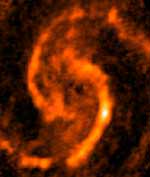
Image credit: NRAO
Astronomers studying gas clouds in the famous Whirlpool Galaxy have found important clues supporting a theory that seeks to explain how the spectacular spiral arms of galaxies can persist for billions of years. The astronomers applied techniques used to study similar gas clouds in our own Milky Way to those in the spiral arms of a neighbor galaxy for the first time, and their results bolster a theory first proposed in 1964.
The Whirlpool Galaxy, about 31 million light-years distant, is a beautiful spiral in the constellation Canes Venatici. Also known as M51, it is seen nearly face-on from Earth and is familiar to amateur astronomers and has been featured in countless posters, books and magazine articles.
“This galaxy made a great target for our study of spiral arms and how star formation works along them,” said Eva Schinnerer, of the National Radio Astronomy Observatory in Socorro, NM. “It was ideal for us because it’s one of the closest face-on spirals in the sky,” she added.
Schinnerer worked with Axel Weiss of the Institute for Millimeter Radio Astronomy (IRAM) in Spain, Susanne Aalto of the Onsala Space Observatory in Sweden, and Nick Scoville of Caltech. The astronomers presented their findings to the American Astronomical Society’s meeting in Denver, Colorado.
The scientists analyzed radio emission from Carbon Monoxide (CO) molecules in giant gas clouds along M51’s spiral arms. Using telescopes at Caltech’s Owens Valley Radio Observatory and the 30-meter radio telescope of IRAM, they were able to determine the temperatures and amounts of turbulence within the clouds. Their results provide strong support for a theory that “density waves” explain how spiral arms can persist in a galaxy without winding themselves so tightly that, in effect, they disappear.
The density-wave theory, proposed by Frank Shu and C.C. Lin in 1964, says that a galaxy’s spiral pattern is a wave of higher density, or compression, that revolves around the galaxy at a speed different from that of the galaxy’s gas and stars. Schinnerer and her colleagues studied a region in one of M51’s spiral arms that presumably has just overtaken and passed through the density wave.
Their data indicate that gas on the trailing edge of the spiral arm, which has most recently passed through the density wave, is both warmer and more turbulent than gas in the forward edge of the arm, which would have passed through the density wave longer ago.
“This is what we would expect from the density-wave theory,” Schinnerer said. “The gas that passed through the density wave earlier has had time to cool and lose the turbulence caused by the passage,” she added.
“Our results show, for the first time, how the density wave operates on a cloud-cloud scale, and how it promotes and prevents star formation in spiral arms,” Aalto said.
The next step, the scientists say, is to look at other spiral galaxies to see if a similar pattern is present. That will have to wait, Schinnerer said, because the radio emission from CO molecules that provides the information on temperature and turbulence is very faint.
“When the Atacama Large Millimeter Array (ALMA) comes on line, it will have the ability to extend this type of study to other galaxies. We look forward to using ALMA to test the density-wave model more thoroughly,” Schinnerer said. ALMA is a millimeter-wave observatory that will use 64, 12-meter-diameter dish antennas on the Atacama Desert of northern Chile. Now under construction, ALMA will provide astronomers with an unprecedented capability to study the Universe at millimeter wavelengths.
The Whirlpool Galaxy was discovered by the French comet-hunter Charles Messier on October 13, 1773. He included it as object number 51 in his now-famous catalog of astronomical objects that, in a small telescope, might be mistaken for a comet. In 1845, the British astronomer Lord Rosse discovered the spiral structure in the galaxy. For amateur astronomers using telescopes in dark-sky locations, M51 is a showpiece object.
The National Radio Astronomy Observatory is a facility of the National Science Foundation, operated under cooperative agreement by Associated Universities, Inc.
Original Source: NRAO News Release
Cassini’s Orbital Entry Spot
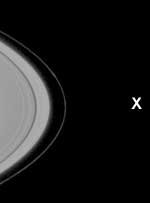
Image credit: NASA/JPL/Space Science Institute
The path that lies ahead for the Cassini -Huygens mission is indicated in this image which illustrates where the spacecraft will be just 27 days from now, when it arrives at Saturn and crosses the ring plane 25 minutes before performing its critical orbital insertion maneuver.
The X indicates the point where Cassini will pierce the ring plane on June 30, 2004, going from south to north of the ring plane, 25 minutes before the main engine fires to begin orbital insertion. The indicated point is between the narrow F-ring on the left and Saturn?s tenuous G-ring which is too faint to be seen in this exposure.
The image was taken on May 11, 2004 when the spacecraft was 26.3 million kilometers (16.3 million miles) from Saturn. Image scale is 158 kilometers (98 miles) per pixel. Moons visible in this image: Janus (181 kilometers, 113 miles across), one of the co-orbital moons; Pandora (84 kilometers, 52 miles across), one of the F ring shepherding moons; and Enceladus (499 kilometers, 310 miles across), a moon which may be heated from within and thus have a liquid sub-surface ocean.
The Cassini-Huygens mission is a cooperative project of NASA, the European Space Agency and the Italian Space Agency. The Jet Propulsion Laboratory, a division of the California Institute of Technology in Pasadena, manages the Cassini-Huygens mission for NASA’s Office of Space Science, Washington, D.C. The imaging team is based at the Space Science Institute, Boulder, Colorado.
For more information about the Cassini-Huygens mission, visit http://saturn.jpl.nasa.gov and the Cassini imaging team home page, http://ciclops.org.
Original Source: CICLOPS News Release
Transit of Venus Starts Soon
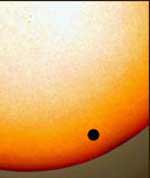
Image credit: NASA
Want to see the 2004 Transit of Venus? Be prepared to wake up early.
On Tuesday morning, June 8th, for the first time since 1882, Venus will pass directly between Earth and the Sun. For six hours the planet’s black silhouette will crawl across the face of our star. It might be a pretty sight, or not. No one can say for sure because no one alive today has seen a transit of Venus.
If you live near the east coast of North America, you can see the crossing. The transit will be underway at dawn and visible for as much as two hours after sunrise.
Before you read the rest of this story, a reminder: Never look at the Sun without eye protection. The early morning Sun rising through the mist, reddened and dimmed by distant clouds, is so tempting; it seems safe to stare. Don’t! Even a low-hanging Sun can cause eye damage. Proper transit-watching techniques are discussed below.
The transit begins at 1:13 a.m. EDT (in the middle of the night) and ends at 7:26 a.m. EDT. If you can see the Sun before 7:26 a.m. EDT, then you can see the transit. Sky watchers east of the Mississippi River are favored. The transit will not be visible at all from Mexico, British Columbia and the following US states: Arizona, California, Colorado, Idaho, Nevada, New Mexico, Montana, Oregon, Texas, Utah, Washington, Wyoming.
A transit of Venus isn’t like a solar eclipse. The Sun won’t be blotted out or even noticeably dimmed. Venus is too small; the disk of the planet covers only 0.1% of the Sun.
Although Venus is tiny, you can probably see it without magnification. Try looking through a safe solar filter, for example, #13 or #14 welder’s glass or special “eclipse glasses” designed for solar viewing. (Do NOT use stacked sunglasses, metallized candy wrappers or compact disks; these are unsafe filters often recommended in error.) Seen through a good filter, the Sun looks like a glowing disk, about the size of the Moon, marked with a black speck–Venus.
The view is much better through a telescope. But beware: sunlight focused through a telescope can blind you instantly. There are two ways to to safely observe using a telescope:
Solar projection is one way. Align your telescope with the Sun. Do not look through the telescope or its finder scope; use shadows on the ground to effect the alignment. The shadow of a telescope looks skinniest when it is pointing directly at the Sun. Once the Sun is in the field of view, an image will shoot out of the eyepiece. Hold a white screen behind your ‘scope and, voila: a picture of the Sun. Adjust the focus of the telescope (or the distance between the eyepiece and the screen) until Venus looks crisp and round.
Solar filters are another way. Capping your telescope with a suitable sun-filter can reduce the intensity of sunlight to safe levels. Then you can look right through the eyepiece. If you’re not sure what filter is safe, contact the vendor of your telescope to ask for advice.
In addition to Venus, you’ll likely see one or two sunspots. These are planet-sized islands of magnetism floating on the Sun’s surface. Compare the two: Venus’ silhouette is dark and round like a planet. Sunspots are not so dark; and they are delightfully irregular.
A moment of special interest is “third contact” at 7:07 a.m. EDT. This is when Venus’ silhouette touches the Sun’s limb and starts its 20-minute egress from the solar disk. Third contact is the beginning of the end of the transit.
Moments before third contact, watch out for the infamous “black drop effect.” The black of space beyond the Sun’s limb will seem to reach in and touch Venus, merging with the planet to form an elongated black drop. You can recreate the black drop effect with your thumb and index finger: Hold the two in front of one eye and narrow the distance between them. Just before they touch, a shadowy bridge will spring across the gap. According to John Westfall, writing for Sky & Telescope magazine in June 2004, “this is simply the result of how two fuzzy bright-to-dark gradients add together.” The black drop effect was troublesome to 18th and 19th century astronomers who tried to measure the solar system by timing transits of Venus.
Troublesome then, fun and challenging now.
If you plan to try observing Venus on June 8th, you might want to practice on June 6th or 7th. Set up your telescope in a place where you’ll have a clear view of the Sun rising over the eastern horizon. Can you project an image of sunspots onto a wall or screen? If so, you’re ready for Venus.
And if you oversleep … mark your calendar for the next transit of Venus: June 6, 2012. Good luck!
Original Source: NASA Science Article
Opportunity Will Enter the Crater
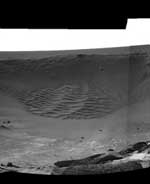
Image credit: NASA/JPL
NASA has decided the potential science value gained by sending Opportunity into a martian impact crater likely outweighs the risk of the intrepid explorer not being able to get back out.
Opportunity has been examining the rim of stadium-sized “Endurance” crater since late May. The rover team used observations of the depression to evaluate potential science benefits of entering the crater and the traversability of its inner slopes.
The soonest Opportunity could enter Endurance is early next week. It will drive to the top of a prospective entry-and-
exit route on the southern edge of the crater and make a final check of the slope. If the route is no steeper than what recent testing runs at NASA’s Jet Propulsion Laboratory, Pasadena, Calif., suggest a rover can climb, controllers plan to radio Opportunity the command to go into the crater.
“This is a crucial and careful decision for the Mars Exploration Rovers’ extended mission,” said Dr. Edward Weiler, NASA’s Associate Administrator for Space Science. “Layered rock exposures inside Endurance Crater may add significantly to the story of a watery past environment that Opportunity has already begun telling us. The analysis just completed by the rover team shows likelihood that Opportunity will be able to drive to a diagnostic rock exposure, examine it, and then drive out of the crater. However, there’s no guarantee of getting out again, so we also considered what science opportunities outside the crater would be forfeited if the rover spends its remaining operational life inside the crater.”
At a rock outcrop in a small impact feature nicknamed, “Eagle Crater,” where Opportunity first landed, the rover found small-scale rock textures and evaporite mineral compositions testifying that a body of salty water covered the site long ago.
The wet environment may have been a suitable habitat for life, if it ever existed on Mars. However, only the uppermost layer of the region’s layered crust was exposed at Eagle Crater, not deeper layers that could reveal what the environment was like earlier.
The rock layer seen at Eagle Crater appears at Endurance Crater, too. At Endurance, though, it lies above exposures of thicker, older layers, which are the main scientific temptation for sending Opportunity inside the crater.
“Answering the question of what came before the evaporites is the most significant scientific issue we can address with Opportunity at this time,” said Dr. Steve Squyres of Cornell University, Ithaca, N.Y., principal investigator for the science instruments on both rovers. “We’ve read the last chapter, the record of the final gasps of an evaporating body of water. What came before? It could have been a deep-water environment. It could have been sand dunes. It could have been a volcano. Whatever we learn about that earlier period will help us interpret the upper layer’s evidence for a wet environment and understand how the environment changed.”
Richard Cook, project manager at JPL for the rovers, said that reaching one exposure of the older rock layers inside Endurance requires driving only about 5 to 7 meters (16 to 23 feet) into the 130-meter-diameter (140-yard-diameter) crater. The rover is on the rim at that site, which had been dubbed “Karatepe.”
“We’ll take an incremental approach, edging our way down to the target,” Cook said. The plan is to use the tools on Opportunity’s robotic arm to analyze the exposed layers for several days, then drive in reverse back up the slope and exit the crater. The slope between the rim and the layered outcrop at Karatepe is about 25 degrees.
“We have done testing that says we can do 25 degrees, provided the wheels are on a rock surface and not loose sand,” Cook said. Engineers and scientists on the rover team built a test surface mimicking the rocks and sand seen in Opportunity’s images of Endurance Crater. The surface was tilted to 25 degrees, and a test rover climbed it. If portions of the route to the outcrop turn out to be between 25 and 30 degrees, the team plans to proceed slowly and use Opportunity to assess the amount of traction the rover is getting.
Opportunity and its twin, Spirit, successfully completed their primary three-month missions on Mars in April.
JPL, a division of the California Institute of Technology in Pasadena, manages the Mars Exploration Rover project for NASA’s Office of Space Science, Washington. Images and additional information about the project are available from JPL at:
Book Review: The Fabric of the Cosmos
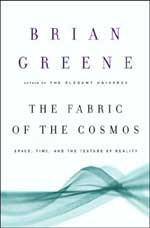
And to add life you need to know what it is all about. Consider that most people believe humans are not at the centre of everything. So if we’re not at the centre, then where exactly are we? Well, centre is pretty much a matter of perspective, and when considering the cosmos, there is a lot of perspective. Newton had things nicely arranged by putting equations and relationships onto macroscopic objects. He had forces and masses and orbits, but he was a little wishy washy on what held it all together. Were the visible constituents all that there was, or was there more? The answer, we know, is, of course, there is more. There are atoms, photons and quarks. Even more tantalizing are fields. Magnetic or electric fields extend from a source to a destination without needing intermediary material. This then is the ticket. This defines the constituents of our surroundings, our existence, our life.
But is this as deep as things get, or can we get deeper? As we delve into smaller and smaller realms, some of our traditional observations and laws get broken. Communication is not supposed to go faster than the speed of light. Yet there is nonlocality, the instantaneous transfer of information, that has been observed when identifying the spin of electrons. And speaking of electrons, those sneaky little particles, we can’t even be sure of where they are or where they are going. Measuring one of their parameters clouds the observation of the other. Not fair! And further, unless we do measure them, the electron may just be anywhere. A probability function is our best guess on where it may be. We see delving into the ‘small’ shows a tricky non-classical view, but things get even hairier.
Let’s look at the bigger picture, our universe. Measurements indicate it’s growing in size and its growth is accelerating. Perhaps surprisingly, there is an ambient temperature of about 2.7 degrees Kelvin. But temperature is an indication of energy. What emits or carries this energy and where did it come from? We’re pretty sure it came from the Big Bang, but we’re not sure what this event was. Nor are we positively sure how we got from that time to this time. Various inflationary steps may have occurred perhaps all of which were driven by some desire to increase entropy. And then, what about time. Is time an inviolate unidirectional dimension? Worm holes may provide a chance to travel in time, but we have yet to see anyone from the future popping by. When looking at the expansion of our view, it is just as freaky as the shrunken version. No wonder theoretical physicists seem to always have a perplexed look.
And how does this all come together? Well, aside from the fact that it is the existence in which we find ourselves, there is nothing definite. But imagine a superstructure of strings, small and large, open and closed. These perplexing little entities can vibrate with special harmonics and purportedly give rise to what we call an electron or a graviton or some field effect. These strings may fill the space that Newton saw as black nothingness but still we can’t prove this as we can’t yet see any. They may even be the reason why some people consider the universe and ourselves to be a holographic image being played out from a lower dimensional frame. Now that’s neat stuff for a cocktail party.
Well, this book on the cosmos will guide the reader through the popular and likeliest hypothesis in theoretical physics today. Illustrative examples and experiments provide wonderful substance to esoteric princeps. Picture Bart Simpson cruising on a skate board to the Andromeda galaxy to pick up some fish and chips. Or there are Mulder and Scully of X-Files notoriety who get mysterious packages mailed to them from aliens. Classical mechanics is intertwined with string theory and teleportation. The gist is there but the breadth of this book, like the cosmos, can be daunting.
Now there could still be a problem if you read this book and then attend a party. The problem is that others in attendance may be equally or better versed. And sadly, many of the enclosed arguments surrounding string theory rest on the laurels of mathematical gurus that say the ‘new’ equations solve some trite detail. Though there are many references, this hearsay doesn’t really support the conjectures. And face it, any party gets pretty stale very quick when the conversation becomes a ‘he said’, ‘she said’, affair.
So anyway, you’ve read Brian Greene’s book on The Fabric of the Cosmos and you’re now ready for a cocktail party or two. You can wow them with your grasp of black holes and entropic progression. You might even get some mileage from telling everyone that we actually live in a universe of ten or so dimensions and that we just can’t quite yet detect the other 6 or 7 or whichever. And who can say you’re wrong? Even Brian admits that there is a lot of conjecture and precious little evidence in the beauty of our cosmos. So go ahead, read about the cosmos and start on the road to being a bona fide theoretical physicist.
Read more reviews on Amazon.com.
Review by Mark Mortimer.
Galaxy Stripped Clear of Star Forming Material
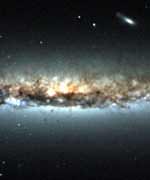
Image credit: NOAO
New observations from the WIYN 3.5-meter telescope on Kitt Peak show striking visual evidence for a galaxy being stripped bare of its star-forming material by its violent ongoing encounter with the hot gas in the center of a galaxy cluster.
This extremely disruptive process is believed to be a major influence on the evolution of galaxies and their star-forming ability over time, but direct observational evidence has been more circumstantial than incontrovertible.
A new three-color composite image of spiral galaxy NGC 4402, taken as the galaxy falls into the Virgo galaxy cluster, shows several key lines of evidence of an ongoing interaction, according to a presentation today in Denver at the 204th meeting of the American Astronomical Society.
NGC 4402 is located more than 50 million light years from Earth, in the midst of the relatively nearby Virgo cluster. As the galaxy moves toward the center of the cluster (located out of the image toward the bottom left), it experiences a ?wind? from the hot cluster gas, which can reach temperatures of millions of degrees.
?This hot wind strips out the much cooler gas and dust in the galaxy. This is important because the gas is raw material for new stars, and once this gas is stripped, the galaxy can no longer form new stars and becomes ?dead? in a sense,? says Hugh Crowl of Yale University, New Haven, CT, lead author of the paper. ?We see at least four distinct lines of evidence for declaring that this ram-pressure stripping process is cleaning out this infalling spiral galaxy.?
* First, the dust disk appears to be truncated, meaning that the light from stars extends out well beyond where gas and dust is observed. ?Since we believe that stars are born in clouds of gas and dust, this suggests that some of the material must have been stripped from the galaxy after the stars were born,? Crowl explains.
* Second, the dusty disk appears to be ?bowed? upward; that is, it has been bent by the wind blowing from the southeast (from the lower left of the image).
* Third, it appears that the light emitted by the north side of the stellar disk has been reddened and dimmed by dust that has been pushed up in front of it by the pressure of the cluster gas. Simultaneously, the dust to the south of the disk has been removed, revealing young blue stars glowing behind it.
* Finally, some of the most unusual features of NGC 4402 are the linear filaments of dust to the south of its main disk. ?These remarkable filaments originate in clumps that appear to be the densest remnants of the now displaced disk of the galaxy,? Crowl says.
The filaments are being ?ablated,? or stripped away, in an outside-in fashion, similar to the process observed in much smaller filamentary features in hot star-forming nebula such as the Eagle Nebula and Pelican Nebula. The hot galaxy cluster wind strips away the outer layers of the cloud, and the dust from these layers is then pushed away. In one case (the eastern or leftmost filament), ?we can see that the wind has either triggered star formation toward the tip of one of these dense clumps or exposed an already-existing star forming region,? Crowl adds.
The bright blue clusters of young stars in the bottom left region of the galaxy?s disk is further evidence of recently triggered star formation.
?This image clearly shows galactic disruption on a grand scale,? Crowl adds. ?It gives us much more confidence that this widely postulated process truly plays a significant role in shaping the evolution of galaxies in clusters.?
This imaging data was obtained with the help of the WIYN Tip-Tilt module, an adaptive optics device that uses a movable mirror to provide first-order compensation for the jittery motion of the incoming image caused by variable atmospheric conditions and telescope vibrations.
This result will be presented in poster 80.12 at the AAS meeting, located in the Ballroom poster session from 9:20 a.m. to 4:00 p.m. Co-authors of the paper are Jeff Kenney (Yale), J.H. van Gorkom (Columbia University), and B. Vollmer (CDS, Strasbourg).
The Wisconsin-Indiana-Yale-NOAO (WIYN) 3.5-meter telescope is located at Kitt Peak National Observatory, 55 miles southwest of Tucson, AZ. Kitt Peak National Observatory is part of the National Optical Astronomy Observatory, which is operated by the Association of Universities for Research in Astronomy (AURA), Inc., under a cooperative agreement with the National Science Foundation (NSF).
Original Source: NOAO News Release
Cassini Ready to Begin Its Saturn Tour
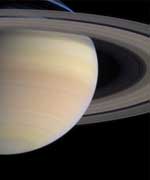
Image credit: NASA/JPL
The international Cassini-Huygens mission is poised to begin an extensive tour of Saturn, its majestic rings and 31 known moons. After a nearly seven-year journey, Cassini is scheduled to enter orbit around Saturn at 7:30 p.m. PDT (10:30 p.m. EDT) June 30, 2004.
“The Saturn system represents an unsurpassed laboratory, where we can look for answers to many fundamental questions about the physics, chemistry and evolution of the planets and the conditions that give rise to life,” said Dr. Ed Weiler, associate administrator for space science at NASA Headquarters, Washington, D.C.
Launched Oct. 15, 1997, on a journey covering 3.5 billion kilometers (2.2 billion miles), Cassini is the most highly instrumented and scientifically capable planetary spacecraft ever flown. It has 12 instruments on the Cassini orbiter and six more on the Huygens probe. The mission represents the best technical efforts of 260 scientists from the United States and 17 European nations. The cost of the Cassini mission is approximately $3 billion.
The Cassini-Huygens mission is a four-year study of Saturn. The 18 highly sophisticated science instruments will study Saturn’s rings, icy satellites, magnetosphere and Titan, the planet’s largest moon.
For the critical Saturn orbit insertion maneuver, the spacecraft will fire its main engine for 96 minutes. The maneuver will reduce Cassini’s speed and allow it to be captured into orbit as a satellite of Saturn. Cassini will pass through a gap between two of Saturn’s rings, called the F and G rings. Cassini will swing close to the planet and begin the first of 76 orbits around the Saturn system. During Cassini’s four-year mission, it will execute 52 close encounters with seven of Saturn’s 31 known moons.
There are risks involved with orbit insertion, but mission planners have prepared for them. There is a backup engine in case the main engine fails. The region of passage through the ring plane was searched for hazards with the best Earth- and space-based telescopes.
Particles too small to be seen from Earth could be fatal to the spacecraft, so Cassini will be turned to use its high-gain antenna as a shield against small objects.
Saturn is the sixth planet from the sun. It is the second largest planet in our solar system, after Jupiter. The planet and its ring system serve as a miniature model for the disc of gas and dust surrounding the early Sun that formed the planets. Detailed knowledge of the dynamics of interactions among Saturn’s elaborate rings and numerous moons will provide valuable data for understanding how each of the solar system’s planets evolved.
The study of Titan, Saturn’s largest moon, is one of the major goals of the mission. Titan may preserve, in deep-freeze, many of the chemical compounds that preceded life on Earth. Cassini will execute 45 flybys of Titan, coming as close as approximately 950 kilometers (590 miles) above the surface. This will permit high-resolution mapping of the moon’s surface with an imaging radar instrument, which can see through the opaque haze of Titan’s upper atmosphere.
“Titan is like a time machine taking us to the past to see what Earth might have been like,” said Dr. Dennis Matson, Cassini project scientist at NASA’s Jet Propulsion Laboratory, Pasadena, Calif. “The hazy moon may hold clues to how the primitive Earth evolved into a life-bearing planet.”
On Dec. 25, 2004 (Dec. 24 in U.S. time zones) Cassini will release the wok-shaped Huygens probe on its journey toward Titan. Huygens will be the first probe to descend to the surface of a moon of another planet. It will also make the most distant descent by a robotic probe ever attempted on another object in the solar system. On Jan. 14, 2005, after a 20-day ballistic freefall, Huygens will enter Titan’s atmosphere. It will deploy parachutes and begin 2.5 hours of intensive scientific observations. The Huygens probe will transmit data to the Cassini spacecraft, which will relay the information back to Earth.
JPL designed, developed and assembled the Cassini orbiter. The European Space Agency managed the development of Huygens and is in charge of operations of the probe from its control center in Darmstadt, Germany. The Italian Space Agency provided the high-gain antenna, much of the radio system and elements of several of Cassini’s science instruments. JPL manages the overall program for NASA’s Office of Space Science, Washington, D.C.
For information about the Cassini-Huygens mission to Saturn and Titan on the Internet, visit: http://www.nasa.gov/cassini or http://www.esa.int/Cassini-Huygens.
Original Source: NASA/JPL News Release
Watch the Venus Transit on the Internet
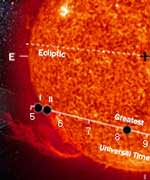
Image credit: NASA
NASA invites you to safely view a rare celestial event, one not seen before by any person alive. On June 8, Venus will appear to cross in front of the sun as viewed from Earth. The last “Venus transit” occurred in 1882. The next two Venus transits are on June 6, 2012, and Dec. 11, 2117.
NASA has formed partnerships with observatories, museums, and amateur astronomers to help people safely observe the event. Special precautions are necessary to safely observe the sun. NASA’s Office of Space Science is offering exciting activities and resources for classrooms and museums. Information, resources, opportunities for educational participation, local events and viewing times, are available on the Internet at:
http://sunearthday.nasa.gov
The event may be safely observed over the Internet with images from solar observatories and satellites. For Internet viewing options, including a live webcast from Athens, Greece, made in partnership with the Exploratorium in San Francisco, Calif., visit:
Centennial Challenges Workshops
The Venus transit will be visible from approximately 75 percent of the Earth. For a map of the transit visibility on the Internet, visit:
http://sunearth.gsfc.nasa.gov/eclipse/transit/TV2004/TV2004-Map1b.GIF
Transit times for cities worldwide are available on the Internet at:
http://sunearth.gsfc.nasa.gov/eclipse/transit/TV2004.html
“People using a filter approved for safe solar viewing can expect to see a small black dot, about 1/30 the size of the solar disk, very slowly moving across the sun,” said Fred Espenak, an eclipse expert at NASA’s Goddard Space Flight Center, Greenbelt, Md.
During the 19th century, Venus transits were essential for astronomers to determine the scale of the heavens. Transits were used to calculate a relatively accurate distance from the Earth to the sun. Once that distance was determined, astronomers calculated the size of our solar system. They also calculated distances to nearby stars by measuring how much they appeared to shift against remote background stars, as the Earth progressed in its orbit around the sun.
So critical was this measurement that, beginning in 1761, leading nations sent expeditions to remote corners of the globe to exactly time when Venus appeared to begin its transit of the sun. The precise timing of the transit depended on location, because different places on the Earth observed the event from different angles. The times were compared, and the distance to the sun calculated using the known distances between expedition locations on the Earth and trigonometry.
The transit phenomenon also has relevance for the future of astronomy. Scientists with NASA’s Kepler mission hope to discover Earth-like planets outside our solar system by searching for transits of other stars by planets that might be orbiting them.
NASA’s Kepler mission is scheduled for launch in October 2007. It will allow astronomers to find planets, perhaps the size of Earth, orbiting other stars by looking for tiny dips in the brightness of a star when a planet crosses in front of it. Periodic brightness dips will signal the presence of a planet in orbit around the star, even if the planet is not directly visible. For information about the Kepler mission on the Internet, visit:
